Infrared water detectors are sophisticated devices designed to use
infrared technology for the detection of water. They are equipped with
the ability to discover and locate moisture or water leaks that are
unnoticeable to the human eye. This mechanism is highly effective as it
employs the properties of thermal energy or heat radiation to detect
temperature variation, a key indicator of water presence. The technology
takes into account that water has different thermal properties compared
to other materials. This fascinating technology has found application in
a variety of fields, both residential and industrial, making it an
invaluable tool in our daily lives. From detecting leakages in
residential plumbing systems to mapping moisture content in large
industrial environments, infrared water detectors have proven to be a
revolutionary technological advancement.
Importance of Infrared
Water Detectors
Infrared water detectors are a vital part of many operations, playing
a crucial role in safeguarding properties from potential water damage.
These detectors alert homeowners and businesses to the presence of
unwanted water in areas that could prove damaging, helping to prevent
considerable structural damage and expensive repairs. Beyond use in
homes, their applications extend to industries such as construction,
real estate, and facilities management, where they can detect pipe leaks
and moisture accumulation as soon as they occur. In the field of
environmental monitoring, they contribute significantly to assessing
water quality and temperature. Hence, infrared water detectors are more
than just a tool; they are an essential asset in ensuring the safety,
longevity, and efficiency of our homes and industries.
Understanding Infrared
Technology
The Science Behind
Infrared Detection
Infrared (IR) detection is a remarkable scientific innovation that
relies on understanding the electromagnetic spectrum. All objects,
living or non-living, emit some form of heat in the pattern of infrared
radiation, which is undetectable by the naked eye. The wavelength of
this emitted heat lies within the infrared spectrum of light, which
spans from just beyond the visible red light to the microwave
region.
The science behind infrared detection revolves around the principle
that different objects, depending upon their temperature and material
composition, emit varying amounts of IR energy or radiation. This
ability to radiate IR energy is called ’emissivity’. IR detectors are
essentially sensitive to this emission and work by receiving and
interpreting this energy.
As the name suggests, these detectors use sensors that are reactive
to infrared light. They convert it into an electric current. This
current then gets amplified and converted into a digital signal which a
processor reads and eventually forms an image or a reading. Thus, the
key to understanding the science of infrared detection lies in its
capability of detecting and interpreting non-visible electromagnetic
wavelengths.
From specially designed lenses to sophisticated sensor arrays, the
field of infrared detection technology is an exquisite blend of physics,
optics, and electronics. While it may sound complex, one can better
understand the concept by picturing these detectors as our eyes, capable
of seeing heat energy instead of visible light. In simple terms, they
transform the “invisible” thermal world into a “visible”, understandable
one.
Application of
Infrared Technology in Various Fields
Infrared Technology has found substantial application across a broad
spectrum of fields due to its ability to capture unseen information from
the environment. One of the most recognizable uses of infrared
technology is in the field of thermography. In substance, thermographic
cameras are used to detect heat patterns and temperature changes in a
particular area. These cameras are regularly used by firefighters to see
through smoke, detect hotspots in fires and locate individuals during
rescue missions.
In the field of healthcare, infrared technology is applied in medical
imaging, where it is used to measure body temperature, monitor blood
flow, diagnose diseases, and even in cancer treatment procedures.
Another life-saving use is in night-vision applications, such as those
used by military and law enforcement agencies. This technology allows
for the detection of heat produced by a body or object in complete
darkness, giving the ability to ‘see’ in the absence of visible
light.
Furthermore, in the telecommunication industry, infrared waves are
used for short-range communication technologies, like television remote
controls, wireless headset transmission, and printer-to-computer
connections. The home security domain uses infrared motion detectors to
sense trespassers by their body heat, even in complete darkness. Lastly,
in the field of astronomy, infrared technology like infrared telescopes
have made the exploration of dark and dust-obscured regions of space
possible.
Thus, from battling fires to battling illness, enhancing security to
exploring the reaches of space, infrared technology truly has a
versatile and robust range of applications.
Principles of Infrared
Water Detectors
How Infrared Water Detectors
Work
Infrared water detectors work based on the principles of infrared
detection technology. As the name implies, they use infrared light to
detect water. This is made possible by using an infrared emitting
device, often paired with a light sensor.
When the infrared light beam, emitted by the detector, encounters a
water surface, it bounces back to the sensor. The sensor then identifies
the refracted light and interprets it as a sign of water presence.
Consequently, an alert is triggered either visually through light
signals or audibly via beeping sounds. This mechanism enables the user
to be aware of water leaks or potential flooding situations.
The key to this technology is that water has specific absorption
properties in the infrared spectrum, making it easily detectable by the
instrument. The unique interactions are due to the molecular composition
of water and how it absorbs and reflects infrared light in a certain
way.
It’s also important to note that some detectors may carry a number of
sensors with varying sensitivities, thus allowing the device to detect
water at different levels; for instance, high-condensation areas
compared to areas with free water.
Components of an
Infrared Water Detector
An infrared water detector consists of several crucial parts that
help it operate effectively. Here is a rundown of the fundamental
components:
- Infrared Sensor: The core of any infrared water detector is the
infrared sensor, a device that measures infrared light radiating from
objects in its field of view. The sensor works by detecting differences
in thermal radiation and transforming it into readable data. It’s
designed to gauge specific wavelengths of infrared radiation, allowing
it to hone in on the presence of water, which exhibits particular
infrared properties. - Processing Unit: Once the sensor detects potential water
presence, the collected data is passed on to the processing unit. This
unit interprets the data and computes if the level and type of infrared
energy detected align with that of water molecules to provide accurate
results. - User Interface: This component varies depending on the specific
model of the infrared water detector but often includes LED lights,
screens, or sound notifications. It is designed to provide users with
accessible, easy-to-understand alert signals if water presence has been
detected. - Power Supply: Most infrared water detectors rely on battery
power, though some models might be designed to tap into mains
electricity, or even be rechargeable. - Casing/Housing: Lastly, all components are enclosed within a
rugged casing or housing to protect them from external elements. This
casing is usually designed to be waterproof and dust-proof, allowing the
detector to function in various environments, whether it’s a basement
prone to flooding or an industrial site exposed to dust and
debris.
Understanding these components can help users get the most out of the
detection process and ensure they’re relying on a device that offers
precision, reliability, and durability. It is crucial to consider the
quality and characteristics of these components when selecting an
infrared water detector to guarantee effective and efficient water
detection.
The Uses of Infrared Water
Detectors
Residential Applications
In the residential sector, infrared water detectors play a crucial
role in maintaining a safe and disaster-free environment. These devices
are often installed in areas that are prone to water leakage such as
basements, bathrooms, kitchens, and laundry rooms.
For homeowners, one of the primary uses of infrared water detectors
is in the detection and prevention of water leaks. With the ability to
identify even the smallest changes in humidity levels, these devices can
alert homeowners of potential leaks or seeping water that could lead to
significant water damage, mold growth, or structural issues. This early
warning system gives homeowners the chance to address the issue before
it escalates, saving them considerable repair costs down the line.
In addition, these detectors are also used in residential swimming
pools. By tracking changes in pool water levels, the device can provide
timely alerts if the water level drops significantly, indicating a
potential leak.
Another practical application is in the surveillance of garden
irrigation systems. The device can ensure that the system is not
over-watering or under-watering, maintaining the health and longevity of
plants, lawns, and gardens.
Lastly, infrared water detectors are also utilized in smart home
automation systems. The readings they provide enable the system to
adjust humidity levels, control irrigation systems, or shut down water
lines when leaks are detected, thus creating a safer, more efficient
living space.
Industrial Applications
On an industrial scale, the applications of infrared water detectors
are vast and varied. They play a crucial role in the safety and
efficiency of many industries.
One key application is in the oil and gas sector. Here, companies
install detectors to continuously monitor for potential water leakage in
pipelines. This not only helps prevent catastrophic failures, but it
also maximizes operational efficiency by ensuring that systems always
run optimally.
In the manufacturing industry, these devices assist in process
control by helping maintain ideal conditions for different processes.
They monitor and control the moisture levels in raw materials to ensure
the quality of the end product. Similarly, in the textile industry, they
are used to control the wetness of fabrics during the dying process,
contributing to higher quality outcomes.
Infrared water detectors are also indispensable tools in the food and
beverage industry. They help ascertain the presence of moisture content
in packaged products, thereby ensuring compliance with safety standards.
In wineries and breweries, the detectors assist in monitoring
fermentation processes.
The construction industry utilizes these devices for detecting the
presence of moisture in materials. This is particularly important during
construction processes, where excess moisture in concrete or other
construction materials can lead to structural integrity issues.
Overall, the use of infrared water detectors in various industrial
sectors contributes significantly to improved safety standards,
heightened product quality, and increased operational efficiency.
Benefits of Using
Infrared Water Detectors
Accuracy and Efficiency
Infrared water detectors offer unparalleled accuracy and efficiency
in identifying and locating water presence, leakage, or damage. The main
strength of infrared technology lies in its precision. It accurately
detects even the smallest temperature variations caused by moisture.
Unlike other traditional methods of moisture detection, which may
deliver false positives due to factors like metal or cold air drafts,
infrared detectors focus primarily on temperature differences, thus
providing precise results.
Efficiency is another significant benefit of using infrared water
detectors. It allows rapid scanning of large areas, detecting moisture
issues well before they become visible to the naked eye. This quick
identification can result in prompt corrective action, thereby
preventing further spread of the damage. With its capacity to operate
quickly and accurately, infrared water detection technology serves as a
vital tool in maintaining the integrity of both residential and
commercial structures, proving its efficiency time and time again.
Non-Destructive and Safe
One of the primary advantages of using infrared water detectors is
their non-destructive and safe nature. Unlike some traditional methods
of water detection that may require invasive procedures to assess and
identify water leaks or dampness, this technology requires no disruption
to structures or surfaces.
As infrared detectors operate on the principle of measuring
temperature variations, they can navigate beneath the surfaces without
any physical intervention. This attribute is particularly important in
scenarios where the integrity of a structure or item is paramount, such
as in heritage buildings, libraries, or expensive wooden flooring.
Moreover, they eliminate the need for unnecessary drilling, cutting, or
breaking into potentially wet areas.
Infrared water detectors also rank high on safety parameters. They
emit no harmful radiation or other dangerous emissions. Their operation
exposes users or inhabitants of a scanned area to no health risks.
Hence, these detectors can safely be used in homes, workplaces, or
public places without worrying about potential risks.
In summary, the non-destructive and safe characteristics of infrared
water detectors make them an optimal choice for identifying water
accumulation in a non-invasive, hazard-free manner.
Real-Time and Continuous
Monitoring
Infrared water detectors offer the invaluable advantage of real-time
and continuous monitoring. This essential feature gives these detectors
an edge over conventional water detectors that may provide intermittent
data or need manual supervision. The infrared sensors are always
vigilant, scanning non-stop for any changes in the environment.
This real-time data provides users with instant feedback if there are
any concerns, such as leaks or rising moisture levels. Such prompt
notification can make all the difference in preventing minor issues from
escalating into significant problems that require costly repairs.
Furthermore, the continuous monitoring capability of infrared water
detectors reduces the need for manual checks or labor-intensive
investigations. You can have peace of mind knowing that the detector is
working round-the-clock, ensuring the security of your property every
second of the day.
Thus, the real-time and continuous monitoring provided by infrared
water detectors contribute towards their effectiveness, offering rapid
responses and constant vigilance, providing an unparalleled level of
convenience and assurance to users.
Leading Brands and
Products in the Market
Thorough
Examination of Top-Infrared Water Detectors
As the need for efficient and reliable water detection systems grows,
various brands have emerged at the forefront of manufacturing top-notch
infrared water detectors. Let’s delve into the details of some of these
leading products.
One such product is Honeywell’s Lyric Wi-Fi Water Leak and Freeze
Detector. This device utilizes infrared technology to accurately
identify even the slightest water leak, giving homeowners the peace of
mind they need. It offers Wi-Fi connectivity, allowing it to send
real-time updates to the user’s smartphone whenever a potential leak is
detected.
Another highly-recommended product is the Fluke 279 FC Thermal
Multimeter. This is an industrial-grade detector that combines a digital
multimeter with a thermal imager to quickly and accurately identify
water leaks. Its infrared technology can peer through walls and other
obstructions, making it a valuable tool for any industrial setting.
Not to be overlooked, the Govee Water Sensors are well-regarded for
their longevity and sensitivity. These detectors use infrared signals to
find water leaks, and are capable of covering large areas, making them
ideal for both residential and commercial use.
Lastly, the Zircon Leak Alert WiFi Smart Water Detector is perfect
for those seeking convenience. Thanks to its handling of infrared
technology, this detector can provide precise and swift detection,
sending alerts to your smartphone no matter where you are.
These products make the most out of the power of infrared technology,
delivering top-tier function and reliability. Still, each detector has
its own strengths and nuances, with no one-size-fits-all option
available. It’s crucial to carefully consider the unique requirements of
your residential or industrial application before choosing your ideal
infrared water detector.
Comparisons
and Contrasts Between Different Brands
When diving into the market for infrared water detectors, consumers
will find many reputable brands offering solutions that excel in various
areas. Two significant players in the market are Honeywell and
Airthings, each offering unique product advantages.
Honeywell’s infrared water detectors are lauded for their superior
accuracy and reliability. Their models are equipped with highly
sensitive infrared sensors capable of detecting even the slightest
changes in moisture levels. Honeywell also offers a durable design, with
devices made to withstand various environmental conditions, making them
suitable for heavy-duty industrial applications.
In contrast, Airthings focuses on delivering user-friendly devices
designed for residential use. Their infrared water detectors stand out
for their simplicity and ease of use. These devices often include
features like Wi-Fi connectivity, providing homeowners real-time
moisture alerts and allowing for easier monitoring of their property.
Although perhaps not as ruggedly designed as their Honeywell
counterparts, Airthings detectors offer a stylish and modern aesthetic
appealing to homeowners.
It’s important to note that while Honeywell products typically come
at a higher price point, they offer robust performance and durability.
Airthings, on the other hand, are priced more affordably, making them a
popular choice for homeowners seeking a basic, easy-to-use solution.
In conclusion, the choice between brands like Honeywell and Airthings
largely depends on the individual’s specific needs, budget, and the
intended application of the infrared water detector. By assessing these
factors, one can find the most suitable infrared water detector to
protect their home or business from the risk of water damage.
Conclusion
Recap
of the Importance and Benefits of Infrared Water Detectors
In this article, we have embarked on a comprehensive exploration of
infrared water detectors, highlighting their importance in various
settings. Leveraging infrared technology, these devices provide a highly
efficient and accurate method of detecting the presence of water, making
them an indispensable tool in both residential and industrial
environments.
Key attributes that set these devices apart are their non-destructive
nature and the ability to provide continuous, real-time monitoring.
These crucial qualities boost their indispensability by significantly
reducing damage costs and preventing further potential degradation
caused by undetected water presence.
Furthermore, we discussed the broad range of applications, from home
usage, across detecting water leaks, to significant industrial
applications like monitoring water levels in storage tanks or mapping
water distribution in soil for agriculture. A variety of leading brands
and products available on the market were also highlighted, to guide
potential users in making an informed decision when picking an infrared
water detector.
Given the clear benefits and the broad scope of applications,
embracing infrared water detectors can be a strategic step towards
improved water management. Be it for personal use in residences or on a
larger scale in industries, employing these detectors could lead to
enormous savings, safety, and efficiency. Through this article, we hope
that we have sparked your interest in these valuable devices and
prompted a consideration of their use where applicable in your
environment.
Encouragement
to Consider Using Infrared Water Detectors for Various Purposes
From safeguarding your home against potential water damage to helping
industries operate more efficiently, the value of infrared water
detectors is undeniable. Their high level of accuracy, non-destructive
operation, real-time monitoring, and easy installation make them a
preferred solution for varied usage. As technology continues to evolve
and become more accessible, it is an exciting time to consider employing
these cutting-edge tools in different aspects of our lives.
Whether you are an individual homeowner wanting to better protect
your property, or a business owner aiming to enhance the safety and
productivity of your operations, integrating infrared water detectors
into your activities can provide numerous benefits. With various models
and brands available in the market, there’s an option suited to
virtually every need.
Embracing infrared water detectors is not just a practical step; it’s
a progressive mindset. As we journey into the future, let us harness the
power of infrared technology to help us live more secure, efficient, and
innovative lives.







